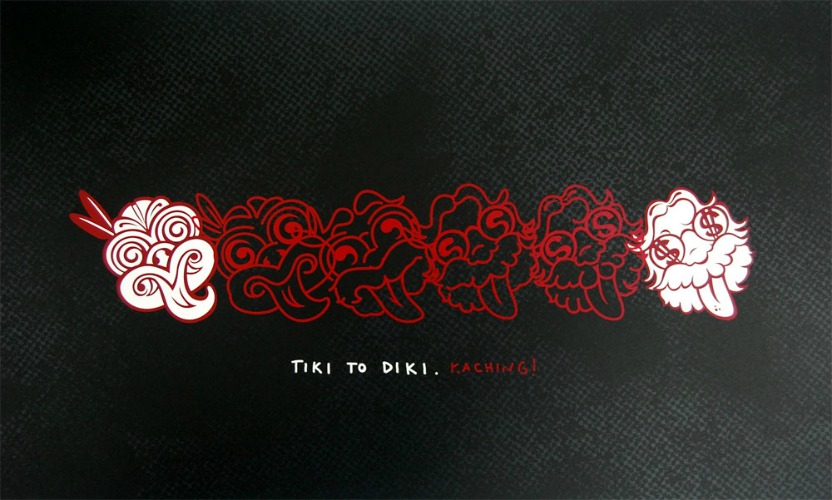If you have anything to do with art in New Zealand, you will at some point encounter Dick Frizzell's 1997 lithograph Mickey to tiki. It’s ubiquitous. It’s apparently New Zealand’s best selling print. It’s also controversial, because there are a lot of Maori who consider Frizzell’s use of the hei tiki image to be cultural appropriation. Mickey to tiki shows an image of Mickey Mouse morphing into a tiki that looks like what you would expect to get if Disney drew their interpretation of a hei tiki. The idea is that there should be no sacred cows in the art world, that so-called “low art” is really no different to “high art”. I can agree with that on a superficial level (artists shouldn’t be afraid to tackle controversial topics), but to me the purpose and cultural context of the art is more important. Art’s more than just a suite of techniques and images. Art has meanings, just like words have meanings. The meaning of a hei tiki and its cultural significance are vastly different to the meaning and cultural significance of Mickey Mouse. I'm not going to get into the whole issue of cultural appropriation because I don’t feel qualified to discuss it, but I personally don’t think it makes much sense to compare the two things in this way.
That said, I do like the way Frizzell used line drawings of the intermediate stages between the two images to depict his metamorphosis. Frizzell had worked as an animator, and it shows. It’s very hard to convey the idea of metamorphosis in one static image, and this is probably the most successful example I’ve ever seen. I think a lot of this work’s popularity comes down to the fact that it’s very well done, very innovative, and very different to anything else that’s out there.
Whatever your views on Mickey to tiki there’s no denying it’s extremely popular, and it forms the basis of Frizzell’s reputation as an artist; as far as I can tell his other major claim to artistic fame is a grocery store mascot (no, I did not make that up). There’s also no denying that Frizzell has shamelessly cashed in on the lithograph’s popularity and the controversy it generated, and milked it for every cent it’s worth.
With that in mind, I’m delighted to bring you Tiki to Diki, a parody by Shane Hansen, who is awesome and deserves a blog post all to himself, which he will get at some stage. The first time I saw Tiki to Diki, I laughed until I was nearly sick. Here, the tiki morphs into a caricature of Dick Frizzell.
It’s the little details that make all the difference. Hansen’s tiki looks a lot more like a real one than Frizzell’s, which I think is a nice acknowledgement of the real cultural context that tiki iconography comes from. Here, it’s Frizzell who is depicted as a cartoon, and I like the way Hansen has used cartoon iconography to suggest that Frizzell is eager to cash in on his creation.
My favourite thing about Tiki to Diki is the tone of the painting. While it is a critique of Frizzell’s work, it's very light-hearted and it has a sense of humour - essentially the painting equivalent of workplace banter. Considering the subject matter, I think it might have been easy for this painting to come across as bitter, or angry, or just jealous at Frizzell's success, but Hansen has got the tone just right and the result is a funny, irreverent painting.
 |
| Picture found here |
That said, I do like the way Frizzell used line drawings of the intermediate stages between the two images to depict his metamorphosis. Frizzell had worked as an animator, and it shows. It’s very hard to convey the idea of metamorphosis in one static image, and this is probably the most successful example I’ve ever seen. I think a lot of this work’s popularity comes down to the fact that it’s very well done, very innovative, and very different to anything else that’s out there.
Whatever your views on Mickey to tiki there’s no denying it’s extremely popular, and it forms the basis of Frizzell’s reputation as an artist; as far as I can tell his other major claim to artistic fame is a grocery store mascot (no, I did not make that up). There’s also no denying that Frizzell has shamelessly cashed in on the lithograph’s popularity and the controversy it generated, and milked it for every cent it’s worth.
With that in mind, I’m delighted to bring you Tiki to Diki, a parody by Shane Hansen, who is awesome and deserves a blog post all to himself, which he will get at some stage. The first time I saw Tiki to Diki, I laughed until I was nearly sick. Here, the tiki morphs into a caricature of Dick Frizzell.
 |
| Picture found here |
It’s the little details that make all the difference. Hansen’s tiki looks a lot more like a real one than Frizzell’s, which I think is a nice acknowledgement of the real cultural context that tiki iconography comes from. Here, it’s Frizzell who is depicted as a cartoon, and I like the way Hansen has used cartoon iconography to suggest that Frizzell is eager to cash in on his creation.
My favourite thing about Tiki to Diki is the tone of the painting. While it is a critique of Frizzell’s work, it's very light-hearted and it has a sense of humour - essentially the painting equivalent of workplace banter. Considering the subject matter, I think it might have been easy for this painting to come across as bitter, or angry, or just jealous at Frizzell's success, but Hansen has got the tone just right and the result is a funny, irreverent painting.
Comments
Post a Comment